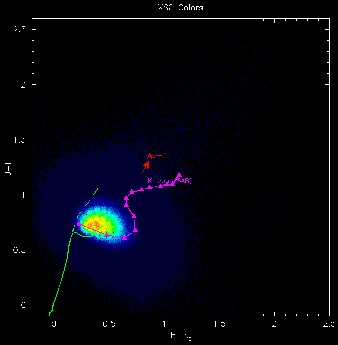
The fiducial elliptical isophotal (20 mag arcsec-2 in the Ks band) mags are used to construct the colors J-H, H-Ks, and J-Ks. The XSC sources (1.65 million total) are sub-divided according to the stellar number density, which measures the surface density of stars that the extended object is projected against.
| density min | density max | %XSC | |Glat| min | |Glat| max |
|---|---|---|---|---|
| 0.0 | 3.2 | 73.4% | ~25 | 90 |
| 3.2 | 3.6 | 19.0% | ~10 | ~25 |
| 3.6 | 4.0 | 6.9% | ~5 | ~10 |
| 4.0 | 4.5 | 0.7% | 0 | ~5 |

Sources with colors that significantly deviate from the "norm" are either (1) intrinsically "red", or (2) characterized by one or more inaccurate fluxes.
Intrinsically red sources are mostly confined to the Galactic Plane (see for example the All Sky Distribution of XSC Sources), and include HII regions, nebulosity, star formation regions (with Young Stellar Objects) and other deeply embedded Milky Way objects. Galaxies may also be very red, either from foreground dust extinction or associations with active galactic nuclei (AGN) or even from significantly red-shifted colors (particularly in the H-K color). See Near-Infrared Galaxy Morphology Atlas for discussion of the different Hubble Galaxy Types as imaged in the near-infrared.
Examples of "Red" Galaxies:
Examples of "Blue" Fuzzies:
Sources with inaccurate colors fall into the catagories of
(1) confused sources, (2) fall within the zone of bright star masking,
usually the J-band is the worst offender
(see
Extended Source Spatial Coverage for discussion of bright
star masking);
(3) isophotal apertures too large (induced by background removal
problems, confusion, contamination from bright star artifacts, etc),
(4) mis-characterized objects (e.g., pieces of galaxies, artifacts,
double galaxies, etc). See also
Visual Inspection of Extended Sources.
[Last Updated: 2003 Feb 24; by Tom Jarrett]